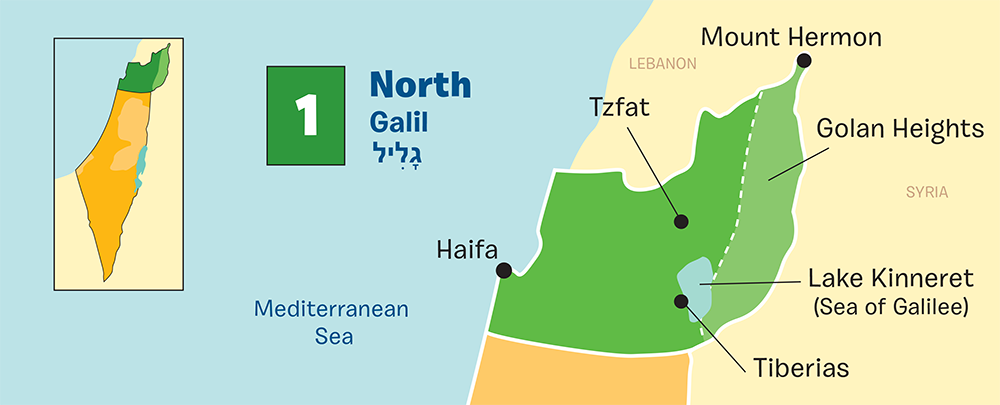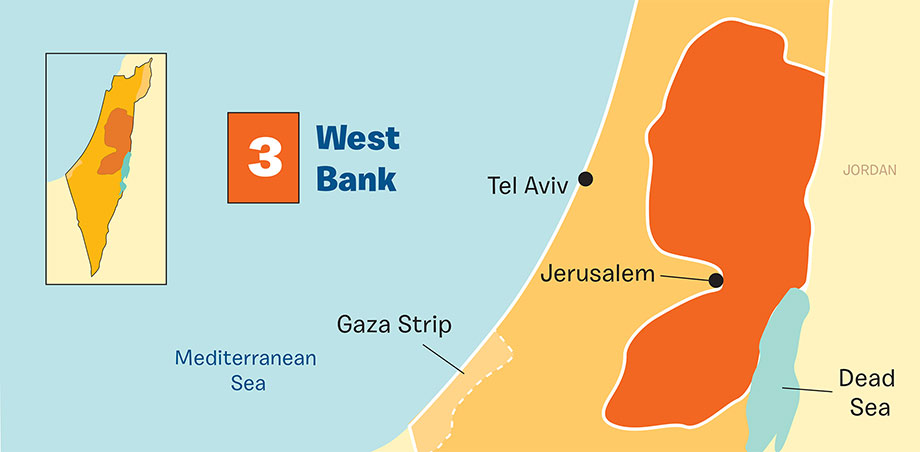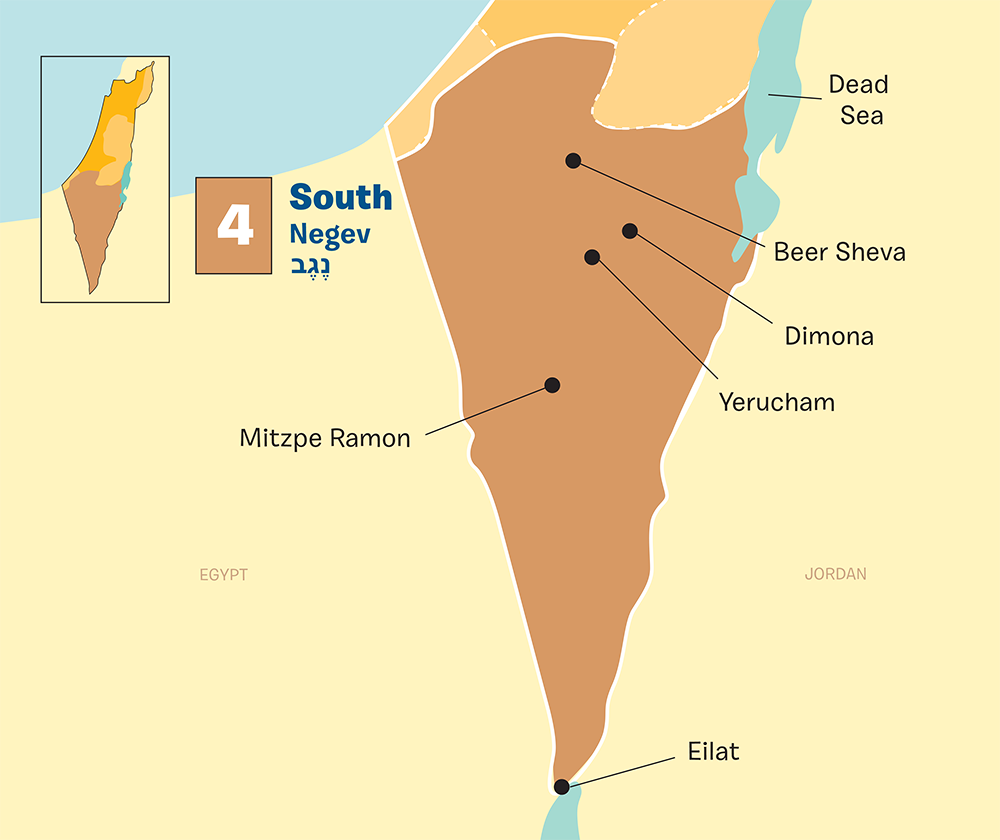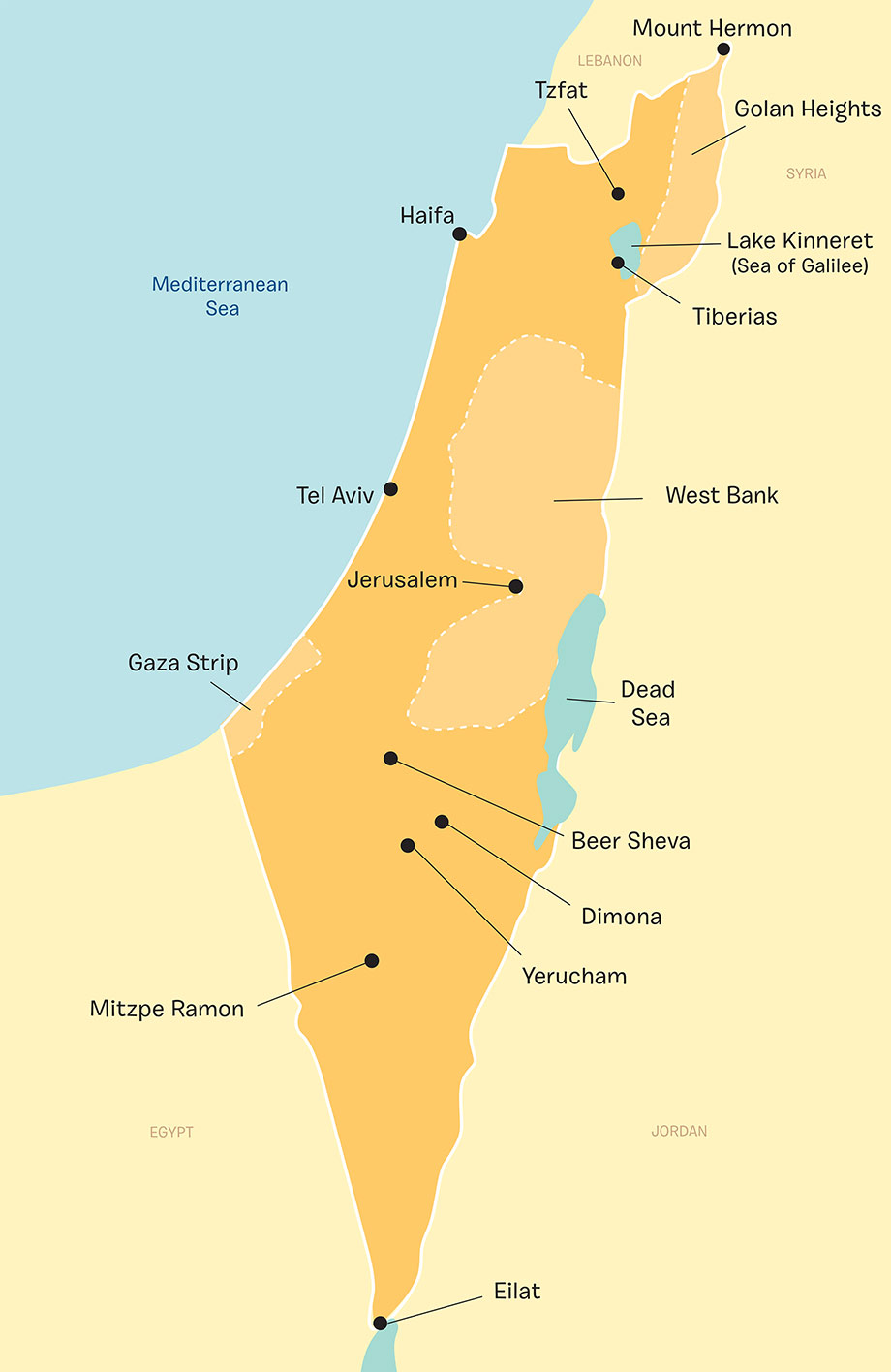In this blog post, PJ Library takes you beyond the Trail Game and reflects — through four areas of the map of Israel — on the meanings and questions that arise in exploring the modern country of Israel.

1. THE NORTHERN PART OF ISRAEL
The northern part of Israel, called the Galil in Hebrew (Galilee in English), is bounded by the Mediterranean Sea to the west, Lebanon to the north, Syria to the northeast, and Jordan to the east.
Cities in the Galil include:
- Haifa, a mixed Jewish-Arab city built on a mountain (like San Francisco) overlooking the Mediterranean.
- Tiberias, built on the shore of Lake Kinneret, the largest Jewish city in the time of the Mishnah and Talmud (2nd-6th centuries C.E.), adjacent to Christian holy sites where Jesus lived and taught.
- Tzfat or Safed, a small mountaintop city that has served as a center of kabbalah (Jewish mysticism) since the 16th century.
The Galil features many Jewish collective settlements — in Hebrew, kibbutzim, moshavim, and yishuvim — and Arab villages dating back many centuries. Fifty-five percent of the total population of the Galil is Arab, and it is the region of Israel where one finds the greatest number of Jews and Arabs living side by side.
The majestic Mount Hermon rises in the northeast corner of the Galil, and extending southward from the mountain to the base of Lake Kinneret is the Golan Heights, an area that Israel took over from Syria in the Six-Day War of 1967.
Historically, the Galil has served as a laboratory for different visions of Jewish community. In each of these visions, an individual’s obligation to the collective was perceived as instilling profound meaning to one’s life.
- In the first centuries of the Common Era, after the destruction of Jerusalem and the Temple by the Romans, the ancient rabbis settled largely in the Galil and created a form of community in which Jewish law (halacha) and study of Torah infused all aspects of daily life. In many ways, Jewish text became the new “land,” and because it was portable, Jews brought this rabbinic paradigm with them to all the countries of the Jewish diaspora.
- In the 16th century, Jews who were expelled from the thriving Jewish center of Spain settled on the Galil mountaintop of Tzfat and developed a new form of Jewish mysticism. The kabbalists (Jewish mystics) believed that every mitzvah (commandment) a Jew performs helps to heal the cosmos. Many Jewish rituals that have become mainstream today, including the traditional Friday night prayer service (Kabbalat Shabbat) and the Tu B’Shevat seder, have their origins in the communal vision of the Tzfat kabbalists.
- At the beginning of the 20th century, groups of young people who mostly rejected rabbinic Judaism (yet still sought some form of Jewish collective living) immigrated from Europe to the Galil to found the first kibbutzim. These people are known as the pioneers (in Hebrew, halutzim), and the Jewish community they formed was built on radical equality and a belief that the land can be redeemed and the Jewish spirit reclaimed through physical labor.
Travelling the Galil, one often wonders, What does community mean to me?
Back to Top

2. THE CENTRAL PART OF ISRAEL
The central part of Israel — the area surrounding the coastal city of Tel Aviv and extending eastward to Jerusalem, known in Hebrew as the Merkaz (center) — is where 80% of Israel’s population lives.
Besides Tel Aviv and Jerusalem, cities in this part of Israel include Netanya, Herzliya, Petach Tikva, Ra’anana, Kfar Saba, Ramat HaSharon, Rishon LeTzion, Holon, Rehovot, Ramla, and Modi’in.
In many ways, the cities of Jerusalem and Tel Aviv — a mere 45-minute drive apart — are the two poles of Israel, and the contrast couldn’t be more striking. These two cities embody different ways that Jews see themselves and search for identity in the modern world.
Jerusalem is ancient — in the words of the poets, the “eternal city.” The biblical King David, in roughly 1000 B.C.E., built it as Israel’s capital, and his son Solomon constructed the Holy Temple as a site of pilgrimage for all Jews. It is a city made of stone, with distinctive Jerusalem stone covering many of the houses and apartments that rise on its rolling hills.
Its population is 60% Jewish (over 1/3 of which are ultra-Orthodox Jews) and 40% Palestinian. As Israel’s national capital, the Knesset (parliament) and other government buildings greet visitors near the entrance to the city. As Israel’s religious capital, the multifaith Old City (with its Jewish, Christian, Moslem, and Armenian quarters, each with its own holy sites) stands to the east of the city, overlooking the desert.
Jerusalem is considered Judaism’s sacred center. Even though the Holy Temple no longer stands, the Kotel (outer wall of the Temple) remains, and Jews from all over the world come to pray at its base. In Jerusalem, there’s a synagogue on almost every block, and Jewish centers of learning of every variety abound. It’s a place where, for many residents and visitors, Judaism offers a source of transcendent meaning. As a Jew, one is responsible for bringing the ethical truths and cultural norms of the Torah to bear in one’s community and within the broader world.
Tel Aviv, on the other hand, is new and thoroughly modern. Established in 1909 on the shore of the Mediterranean Sea, it is a flat city built entirely on sand, the first modern Hebrew city. Much of its architecture reflects the Bauhaus style (European influence), and its skyscrapers dominate the downtown skyline. It is the place where, on May 14, 1948, David Ben-Gurion proclaimed Israel’s independence — a Jewish state among the nations of the world.
Tel Aviv prizes this spirit of independence: it is the cultural and commercial capital of Israel, with connection to business and the arts the world over. It is the LGBTQ+ and vegan capital of Israel, where individuals are free to express themselves without pressure to conform. New forms of Jewish and Israeli identity emerge here in literature and music, in cinema and graffiti art, in social justice work, in a secular yeshiva (Jewish study hall). It’s a place where Jews are free to construct their own meaning in the broader world.
Freedom or truth? Independence or transcendence? These are some of the questions posed as one travels the highway between Tel Aviv and Jerusalem.
Back to Top

3. THE WEST BANK
The large area to the north and south of Jerusalem is called the West Bank because it sits on the western bank of the Jordan River that flows between Lake Kinneret and the Dead Sea.
Clearly, the West Bank and all that it evokes is difficult to talk about with kids. As parents, it’s important that we have some grasp of the facts so that when our kids are ready to talk, we’re ready too.
Prior to the establishment of the modern State of Israel, the area then known as Palestine was under the British Mandate. Following Israel’s Declaration of Independence and the ensuing War of Independence (1947-1949), the West Bank became part of Jordan. (In the 1949 Armistice Agreements, a green line was drawn around this area on a map. This border around the West Bank is known to this day as the Green Line.) In 1967, Israeli forces took command of the West Bank as part of the Six-Day War.
Three million Palestinians live in the West Bank, including in such cities as Ramallah, Jericho, Nablus, Tulkarem, Jenin, Bethlehem, and Hebron. They live in areas administered either by Israel, the Palestinian Authority, or by both and lack formal citizenship of any country. Since 1967, Israeli governments have authorized Jewish settlement in the area, and currently over half a million Jews — citizens of Israel — live in the West Bank.
The status and future of the West Bank is a matter of great dispute, beginning with how one refers to the area: the West Bank, Judea and Samaria (biblical names for the area), disputed territory, occupied territory. Some believe that Israel should permanently control all or much of the area, either for its biblical significance or its importance for Israeli security. Others assert that by international law and principles of human rights, Israel has no claim to the land and should relinquish its control of most or all of it.
The nearby Gaza Strip (30 miles separate Gaza from the southernmost part of the West Bank) was part of Egypt from 1948 to 1967 and under Israeli control from 1967 to 2005. Two million Palestinians live in the Gaza Strip, including in such cities as Gaza City, Khan Yunis, Rafah, and Jabalia. Numerous military operations have been waged between Israel and Hamas-led Gaza since the Israeli withdrawal in 2005, with the war beginning October 7, 2023 by far the most devastating.
Since the 1970s, a two-state solution — which would create an independent Palestinian state in the West Bank and Gaza Strip — has been the focal point of peace negotiations between Israeli and Palestinian negotiating teams. An initial compromise was reached in the early 1990s in the Oslo Accords. These negotiations broke down, and subsequently no meaningful compromise has been reached.
The world — but most of all the community of Israelis and Palestinians — wonders, What will the future bring?
Back to Top

4. THE SOUTHERN PART OF ISRAEL
The southern part of Israel, called the Negev (in Hebrew, negev means “dry”), is the desert region that begins in the Judean Hills near Jerusalem and extends to the southernmost point of Israel. The Negev desert comprises about 55% of Israel’s land mass.
Cities in the Negev include
- Beer Sheva, the capital of the Negev, built on an ancient site described in the biblical stories of Abraham and Isaac.
- Dimona and Yerucham, development towns established in the 1950s to house primarily North African immigrants.
- Mitzpe Ramon, a development town turned tourist town, perched on the magnificent Ramon Crater, the world’s largest erosion crater.
- Eilat, a resort town on the Red Sea at the southern tip of Israel.
Have you watched a desert sunset? Or hiked in a desert crater? The stark beauty, the absolute silence — these are desert experiences that have long inspired humanity to feel connected to something in this world and, at the same time, beyond this world.
The desert, with all its beauty and power, is part of the Jewish people’s DNA. In Jewish tradition, Abraham came to the Negev desert as part of his spiritual journey, and he and Sarah opened their tent to strangers. The Israelites wandered in the desert for 40 years and, as free people, received an ethical blueprint through a wilderness revelation.
It is in this boundless, sometimes brutal, always awesome space that the Jewish people learned about freedom and limits, about exaltation and humility.
When visitors come to the Negev, they can squint and imagine — riffing on the Bible—that that bush once burned or that that rock once gushed with water. Nowadays they can also marvel at how human ingenuity has created sustainable settlements in the middle of the Negev — kibbutzim with beautiful landscapes and thriving agriculture, towns with culture and tourism, all reflecting the vision of Israel’s first prime minister, David Ben-Gurion, who called on Jews everywhere to “come to the Negev and make it bloom.”
In the Negev, I might ask myself, How did everything begin? Why was Judaism born in the desert? How does my human spirit and Jewish spirit connect with this place?

Back to Top
PJ Library would like to thank the Nesiya Institute for materials which inspired the writing of this blog.
March 7, 2023